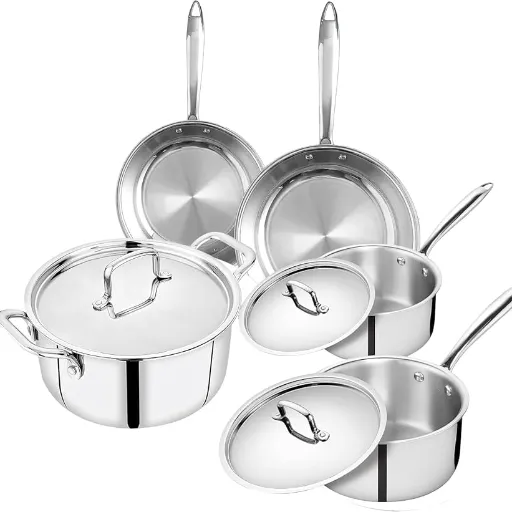Cooking is not only about the food—it’s a form of expression, a science, and a passion for many people. The kitchen tools make a huge difference, and if there is one cookware that has won the hearts of both the home cooks and the chefs, it is stainless steel. But from all the cookware options, stainless steel is still preferred most. There are many reasons and among them are its longevity, excellent heat distribution, and beautiful professional look. We will look into the stainless steel cookware benefits in this article, will give you the factors to consider in choosing a set, and will share some tips to keep your pots and pans always performing at their best. Whether you are improving your kitchen tools or you are completely new to cooking, this guide will be like a helper on your way to make the right choice of the ultimate culinary buddy.
Introduction to 18/0 Stainless Steel Cookware
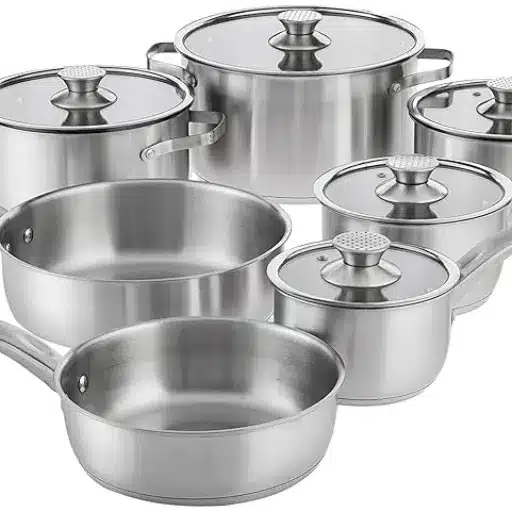
If you are looking for a material that is going to last a long time, is economical to buy and is resistant to rust and corrosion, then 18/0 stainless steel cookware is your best option. The combination of 18% chromium and 0% nickel in its composition does not make it magnetic and also makes it a good choice for those who prefer nickel-free cookware, but it still gives the kitchen a dependable performance.
What is 18/0 Stainless Steel?
The composition of 18/0 stainless steel is that of chromium which is the main element in providing this type of steel with corrosion resistance. It manufactures a very thin layer of oxide on the top surface of the steel to shield it from rust and staining. Nickel, on the other hand, is the element that raises the price of 18/0 stainless steel compared to the rest of the grades like 18/8 or 18/10 which are nickel-inclusive for being more durable and shiny.
The 18/0 composition also makes it a magnetic type of stainless steel which is what makes the difference between 18/0 and other non-magnetic stainless steels. The reason it is widely used for kitchen utensils and flatware is its low price and integration with induction cooking. However, it is a little less resistant to corrosion and non-curing over the nickel-inclusive types, therefore it will get the masking and pairing process more intensive over time. But for daily usage, stainless steel of the lowest grade is still on the list of materials for consumers who are looking for quality kitchen wares and essentials at a reasonable price.
Benefits of Using 18/0 Stainless Steel Cookware
18/0 stainless steel cookware is the perfect choice for home cooks and the cost-conscious ones as it has multiple benefits. For one thing, it is very affordable, which is the main attraction. Unlike stainless steels with higher grades such as 18/8 or 18/10, 18/0 is much cheaper thus making it an excellent option for people who wish to have sturdy pots and pans without emptying their wallets.
This alloy is composed of 18% chromium and 0% nickel giving such a distinct plus for those who have nickel allergy. Being entirely nickel-free, it does not cause allergenic reactions thus being safer for some users. Besides, the high chromium level still grants 18/0 stainless steel good corrosion and rust resistance even on normal usage conditions.
Personal Insight: My go-to choice is 18/0 stainless steel cookware which is absolutely nickel-free thus a safer option for persons suffering from nickel allergy. Besides, it provides good resistance against corrosion and rust, hence I don’t have to make a compromise on the aspect of durability.
Stainless Steel Cookware Durability and Longevity
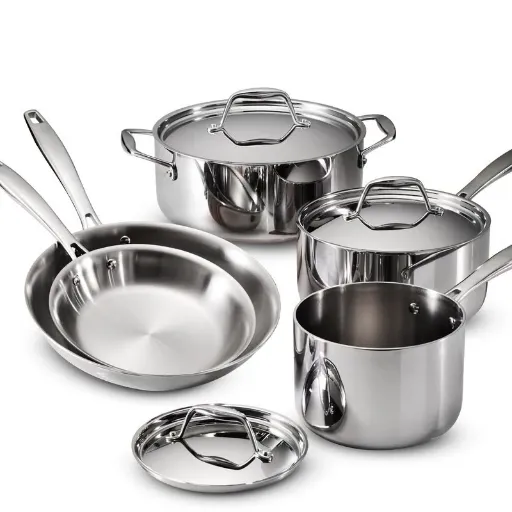
Stainless steel cookware has built a reputation for being durable and long-lasting and thus has become the favorite of both home cooks and professional chefs. The strength of the material comes from its combination—the stainless steel is usually an alloy of iron, chromium and occasionally nickel or carbon. For example, 18/10 stainless steel, which consists of 18% chromium and 10% nickel, is extremely resistant to rust and corrosion and at the same time offers durability due to the presence of nickel. In the same way, 18/0 stainless steel is harder and has more magnetic response, which makes it the best choice for induction cooking; however, it is not as corrosion resistant as the former.
📊 Research Finding: Recent studies support that if handled correctly, the high-end stainless steel cookware can last anywhere between 10 to 20 years or even longer while preserving its basic functionality and appearance. Statista’s 2022 survey stated that almost 75% of consumers chose stainless steel cookware over other materials such as non-stick or aluminum due to its durability that was proven.
Factors such as regular cleaning, not allowing cookware to be immersed in high-acid or high-salt environments for a long time, and preventing overheating can dramatically lengthen the cookware’s life.
Cooking Performance and Heat Distribution

Stainless steel cookware is one of the main benefits because it has excellent heat distribution. This property of stainless steel is further enhanced when it is combined with an aluminum or copper core. Stainless steel has moderate thermal conductivity when used alone; however, very often top quality cookware is made to have a multi-layer structure, for instance, a 3-ply or 5-ply configuration, in which the core layer consists of very good thermal conductors like aluminum or copper.
| Material | Thermal Conductivity (W/m·K) | Heat Transfer Efficiency |
|---|---|---|
| Aluminum | 237 | Excellent |
| Copper | 398 | Superior |
| Stainless Steel | ~16 | Moderate |
The layered structure makes it impossible to have hot spots because they are eliminated like that and also guarantees the surface of the cookware heats up quickly and evenly. For example, professional stainless-steel pans that have an aluminum or copper core reach cooking temperatures in less than two minutes and are still able to hold the temperature. What is more, the enhanced thermal performance is advantageous in the case of searing, as the control of the temperature is very important for getting the desired caramelization and crust.
Comparing 18/0 Stainless Steel Cookware with Other Types
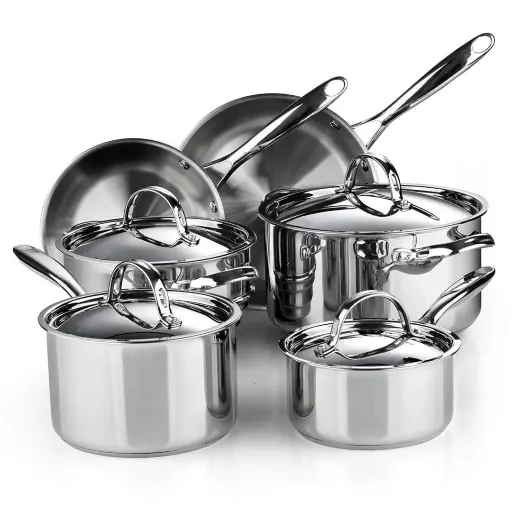
In the comparison of 18/0 stainless steel cookware with other types, the differentials of 18/0 established the fact that it was free from nickel, thus being the best choice for people with nickel allergies. Nevertheless, it was not as good as 18/8 and 18/10 stainless steel that provided better heat-retention, durability, and resistance to corrosion because of the presence of nickel in them.
Tri-Ply vs. Classic Stainless Steel
🔥 Heat Distribution and Cooking Performance
Tri-ply cookware’s conductive core provides it with excellent heat distribution as its main advantage. A research report states that aluminum, a frequently used material in tri-ply cores, transfers heat up to 16 times better than stainless steel. This results in an evenly cooked meal, preventing the formation of hot spots that can burn food. Classic stainless steel, although durable, depends only on external heat conduction, which can lead to uneven heat distribution throughout the cooking period.
💪 Durability and Weight
Tri-ply and classic stainless steel cookware both are recognized for their long-lasting nature and resistance to warping or corrosion due to the stainless steel layer covering them. However, tri-ply cookware is usually heavier because of its multi-layer structure while classic stainless steel remains lighter and easier to use.
💰 Price and Affordability
Tri-ply cookware usually costs more than classic stainless steel because of the advanced construction and materials used. This makes classic stainless steel a more acceptable option for a lot of households in terms of budget.
| Cookware Type | Price Range |
|---|---|
| Tri-Ply Stainless Steel Pot | $80 – $200 |
| Classic Stainless Steel Pot | $40 – $100 |
Benefits of 18/0 Stainless Steel over Other Materials
18/0 stainless steel is by far the most popular option for cookware and kitchen utensils as it has certain properties and advantages over other materials. 18/0 stainless steel is a version of stainless steel that consists of 18% chromium and 0% nickel which not only makes it economical but also gives it certain qualities that meet different cooking needs.
The most important thing about 18/0 stainless steel among all its advantages is that it can withstand rust and corrosion for a very long time because of the high chromium (⌀) that the steel is rich in. This property calls for an emphasis on the matter of the steel’s durability since it can last even in tropical or moisture-prone areas such as kitchens. The opposite is the case with materials like cast iron which need constant seasoning to keep rust at bay, 18/0 stainless steel only needs easy cleaning and maintenance. To add to that, cookware made with 18/0 stainless steel is magnetic and thus, induction cooking is possible with it, a feature not all materials like aluminum or non-magnetic stainless steel can boast of.
Practical Tips for Using and Maintaining Stainless Steel Cookware

Personal Experience: My experience with stainless steel cookware is that one of the best ways to maintain it is to clean it immediately after the use, it is done by soapy warm water gently scrubbing so that no stain remains. Also, I do not use any abrasive materials that are too harsh to avoid scratching.
Cleaning and Care Instructions
🧼 Handwashing is Preferred
Though a lot of stainless-steel cookware is termed dishwasher-proof, still it is advisable to do hand wash with respect to the finish of the cookware. After every use, wash the surface with warm water, mild dish soap, and a soft sponge or cloth. Stay away from applications of rough scrubbers that could lead to the surface being scratched.
🔥 Removing Stubborn Stains and Burnt Food
In case food gets burnt to the cooking pot, fill a pot with warm soapy water and let it soak for a period of 10-15 minutes. For even more stubborn stains, make a paste of baking soda and water. Put the paste on the stained area, gently scrub with a non-abrasive pad, and then rinse the area very well.
💧 Dealing with Water Spots
Hard water is likely to leave unpleasing water spots on stainless steel. To remove these spots, immediately dry the cookware after washing it with a soft microfiber towel. Moreover, you can use a solution of vinegar and water (1:1) to dissolve deposits from minerals.
How to Avoid Rust and Damage
⚠️ Avoid Using Harsh Scrubbers or Cleaners
The use of abrasive scrubbers and cleaners can make the stainless steel surface more prone to rust by scratching it. On the contrary, always use a non-abrasive sponge or soft cloth with mild detergent. In case of tough stains, a paste of baking soda and water can be applied with gentle pressure.
🧽 Dry Thoroughly
It is crucial to dry your cookware completely with a clean towel after washing to avoid water spots and moisture, which could result in rust. It is not advisable to air-dry, as this may leave water in some of the areas, especially if the area has high humidity.
📦 Store in a Dry Environment
While storing cookware, make sure that it is stored in a clean dry environment. Do not stack wet pots and pans; moisture may get trapped and lead to rust over time.
Conclusion and Recommendations
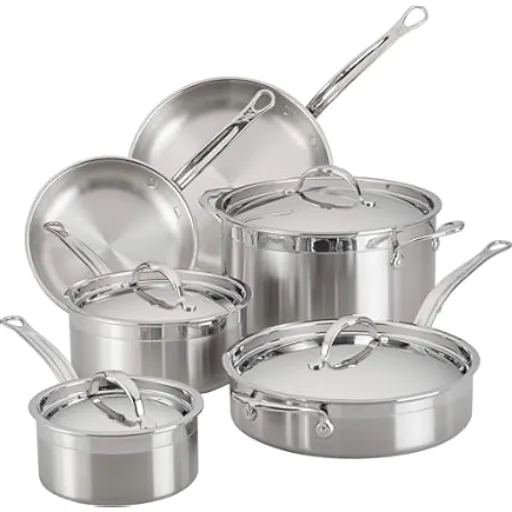
The Benefits of 18/0 Stainless Steel Cookware Summarized
🛡️ Corrosion Resistance
The inclusion of 18% chromium ensures that the cookware is highly resistant to rust and corrosion, and thus, it can be used for a long time even in the kitchen’s high moisture environment. Recent researches show that the durability of cookware with adequate chromium content is immense compared to lower-grade metals when they are water and acidic food subjected to their tested qualities.
🚫 Nickel-Free for Allergy Sensitivity
The cookware containing no nickel is 18/0 stainless steel which is the best option for people who are allergic to nickel. Reports reveal that around 10-15% of the populace might show some allergic reaction to nickel, so the cookware being nickel-free thus becomes a safer and more inclusive alternative.
🧲 Magnetic Properties for Induction Cooking
Nicking-free nature of the cookware amplifies its magnetic capabilities thus making 18/0 stainless steel suitable for induction cooking. The feature is in line with the global trend of using energy-saving induction stoves whose usage is expected to increase by 7% yearly.
Reference Sources
-
HealthCraft Blog
- Title: “Why 18/0 stainless steel Bakeware the best for baking?”
- Key Insights: Discusses the benefits of 18/0 stainless steel, including its nickel-free safety, good heat conduction, durability, and cost-effectiveness.
- Source: HealthCraft Blog
-
Caraway Home Blog
- Title: “18/0 vs. 18/8 vs. 18/10 Stainless Steel”
- Key Insights: Explains the differences between various stainless steel grades, highlighting 18/0 as a budget-friendly option suitable for flatware, serving utensils, and lower-cost cookware.
- Source: Caraway Home Blog
-
Target Product Listings
- Example: KitchenAid 3-Ply Base Stainless Steel Cookware Set
- Key Insights: Provides practical examples of 18/0 stainless steel cookware in the market, showcasing its features like induction compatibility and affordability.
- Source: Target
Frequently Asked Questions (FAQs)
❓ What are the advantages of using tri-ply stainless steel cookware?
Tri-ply stainless steel cookware consists of three layers of metal, mainly aluminum or copper which are sandwiched between stainless steel. This particular design guarantees uniform heat distribution and thereby eliminates the risk of hot spots and improves cooking results. Besides, the tri-ply structure has a long-lasting quality that is the main reason it is the choice of even the most demanding professional chefs and the best-informed home cooks.
❓ Is 18 0 stainless steel cookware safe and free from PFAS?
Absolutely, 18 0 stainless steel cookware is regarded as safe and PFAS free. Unlike some non-stick cookware, stainless steel does not have chemicals that can transfer to food through leaching. This makes it a more health-friendly choice for food preparation, particularly for families that are worried about the risk of chemical exposure.
❓ What is the proper care for stainless steel cookware?
The proper care for your stainless steel cookware is to steer clear of abrasive brushes that could possibly scratch the surface. For routine cleaning, a soft sponge and mild detergent are the perfect combination to use. If you have any stubborn stains, try using a baking soda and water paste. If you follow the care instructions correctly, your cookware will always look as good as new and will be functioning well for many years.
❓ Which brands are providing high-quality 18 0 stainless steel cookware?
There are quite a few good brands that provide high-quality 18 0 stainless steel cookware like All-Clad, Cuisinart, and Heritage Steel. These brand names are recognized for their excellent workmanship and tough designs giving the customers a great variety of products from skillets to stock pots according to different cooking needs.
❓ What kinds of cookware made of stainless steel are there?
There is a wide variety of cookware made out of stainless steel such as skillets, stock pots, saucepans, and frying pans. In addition, many collections include pieces that come with lids which makes them even more versatile for cooking. The range of stainless steel options is huge and one can find a perfect one among them suits his/her needs whether for a heavy-duty stock pot to make soups or a pan with a lid for simmering.

